Internal linking helps Google understand how your website is structured and helps your site’s visitors navigate from page to page in a logical way. It also distributes PageRank — a page with a high PageRank shares its authority with any linked pages.
But the more pages you have, the harder it is to identify and make the most of all your linking opportunities — especially if you’re doing everything manually. Luckily, there are several internal linking tools you can use to speed up the process and ensure that you’re executing an effective linking strategy. In this post, we’re highlighting 15 of our favorites.
1. Internals by Positional
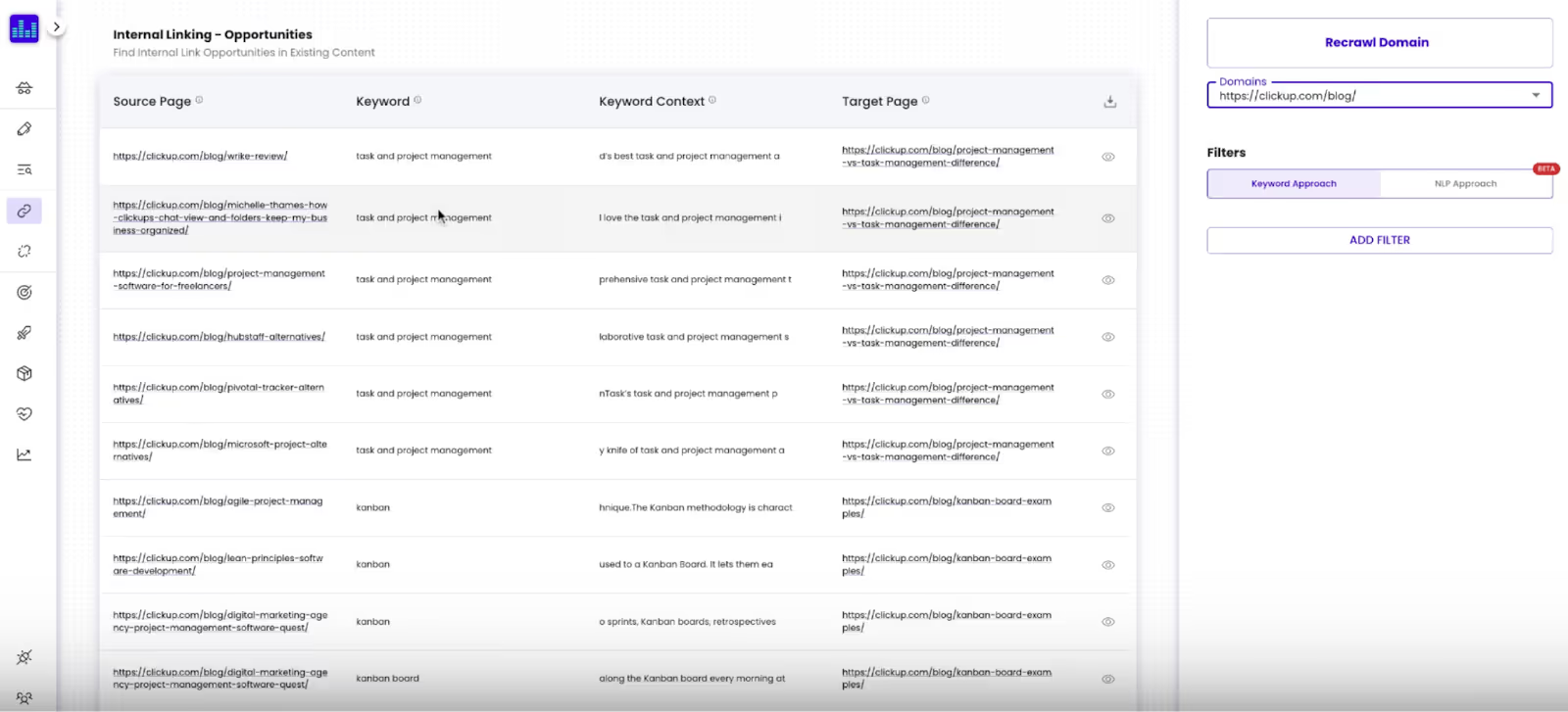
How it works: Internals scans your website for highly contextual internal link opportunities in your existing content. You can pull in multiple domains by integrating the internal linking tool with Google Search Console (GSC), but this isn’t mandatory — it just helps Internals capture GSC query data.
Internals offers a couple of approaches to internal linking:
- Keyword approach: This pulls in all of the URLs from your sitemap and identifies the keywords each page is ranking for using GSC query data (optional) as well as data from third-party APIs. You can then see which pages aren’t currently linked, even though doing so might be beneficial.
- Natural language processing (NLP) approach: This uses your headers and URLs to predict what keywords your pages will rank for and bases linking suggestions on those predictions. It’s a bit less precise than the keyword approach, but it can be useful if you’ve recently published a lot of new content.
- Manual scan: This works best if you’re creating a fresh piece of content. You can copy and paste the content into Internals, and it’ll suggest opportunities to link to and from the pages that already exist on your site.
Features:
- Keyword and NLP approaches for more actionable internal linking opportunities.
- Search for specific opportunities directly or use quick filters to refine opportunities by source page, target page, or keyword.
- Prompts to add internal links to and from new content.
- Pulls URLs directly from your sitemap, so no additional integrations are needed.
- Export as many as 40,000 internal link opportunities into a CSV or spreadsheet.
Pricing: Starts at $299 per month.
Best for: Predicting what keywords your pages will rank for and suggesting internal linking opportunities based on those predictions.
2. Link Whisper
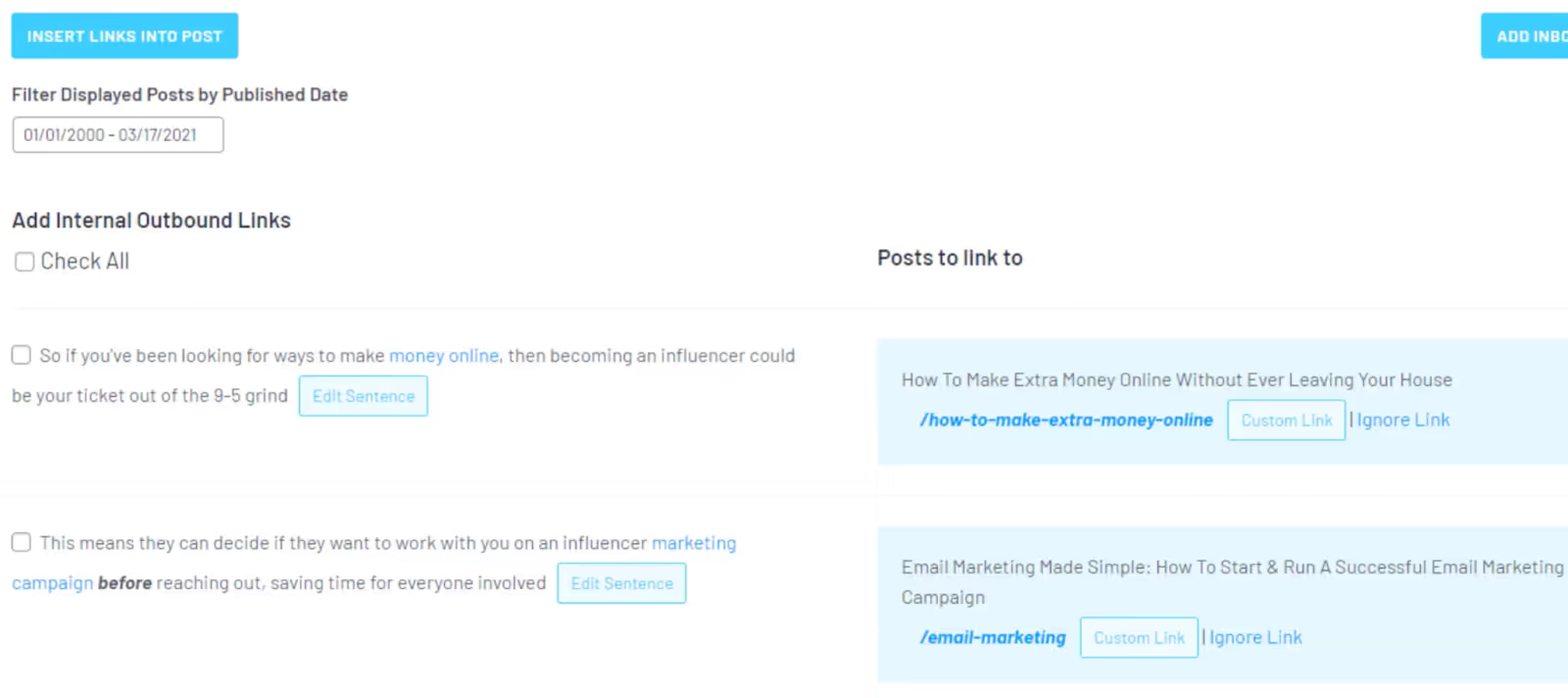
How it works:
Link Whisper is a WordPress plugin that uses artificial intelligence to suggest relevant internal links as soon as you start typing in the WordPress editor. It crawls your entire website to identify pages that don’t have any inbound internal links and recommends opportunities to add them. The auto-linking feature lets you build links from keywords — so all past and future instances of a given keyword will link to the page you choose.
Features:
- Automatic link suggestions are available as soon as you start typing.
- Quickly spot pages that have no internal links pointing to them.
- An auto-linking feature that connects keywords to specific pages.
- Internal links reporting shows how many outbound internal and external links are coming from each page.
Pricing: Starts at $97.
Best for: Generating automatic link suggestions while you write.
3. InLinks
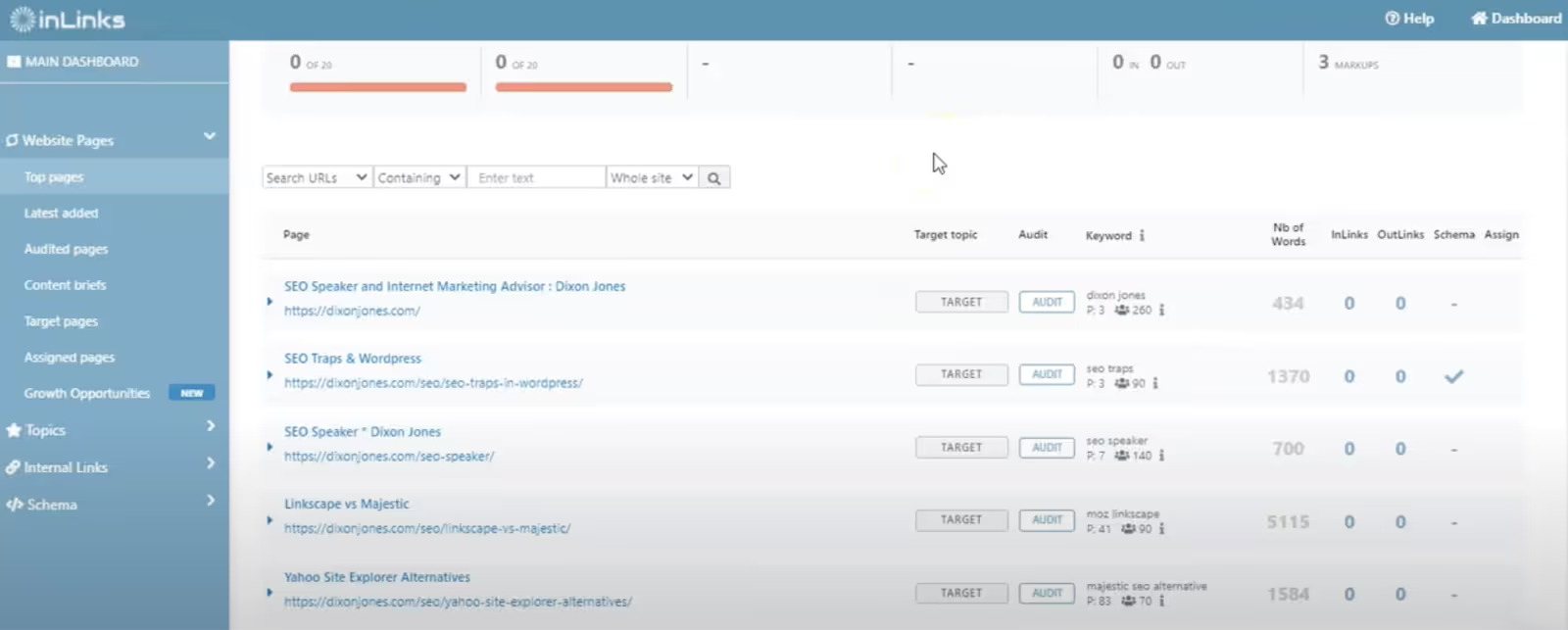
How it works:
InLinks uses a proprietary semantic analyzer and knowledge graph to analyze every page on your website and provide action points: linking opportunities that will help you optimize your site. By adding a small snippet of code to your site, you can perform a semantic analysis to get a list of “entities” (pages and page clusters) and detect anchor linking opportunities.
Features:
- An NLP algorithm that identifies linking opportunities.
- Knowledge graphs that group topic and keyword clusters.
- Internal linking structures that create a network of crawlable internal links.
- JS code that automatically adds optimized internal links directly to your site.
Pricing: Prices start at $49 a month. There’s also a free plan.
Best for: Grouping keyword clusters in a visual knowledge graph.
4. Yoast SEO
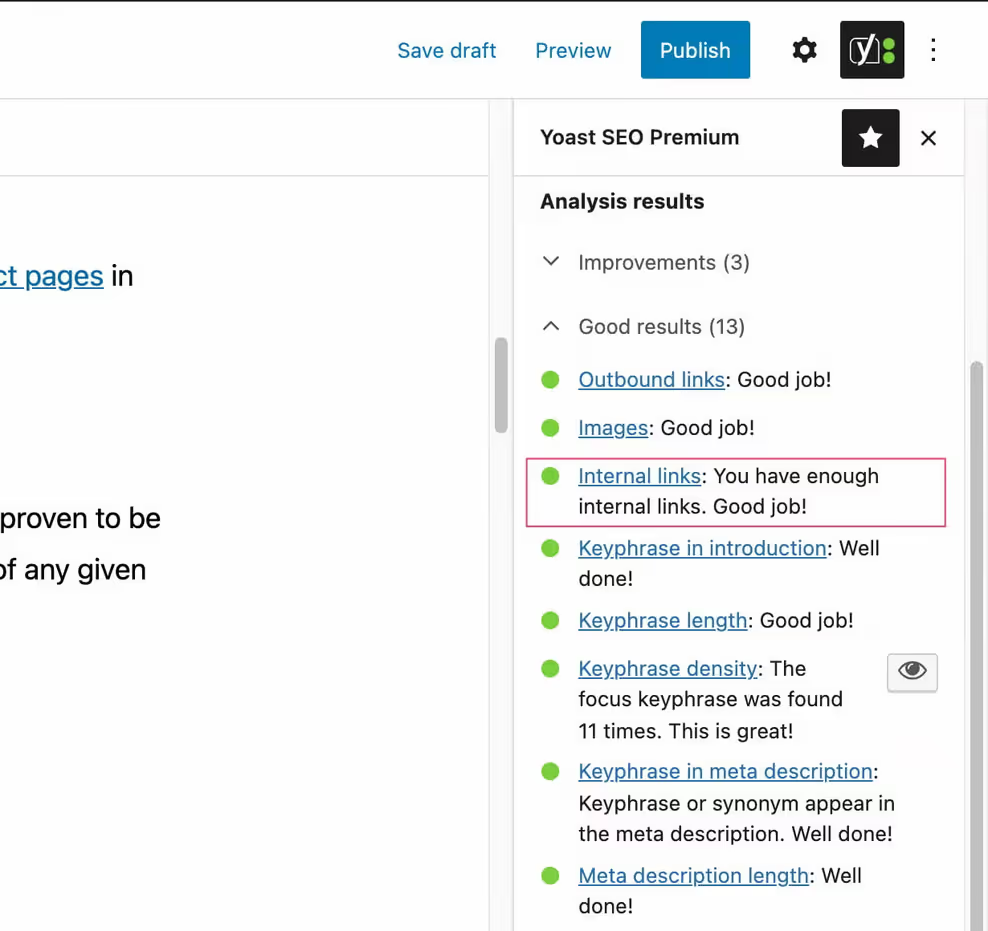
How it works: Yoast SEO is a comprehensive SEO plugin for WordPress and Shopify websites. Its linking tool helps you set up your site structure by suggesting internal links for related content. Suggestions appear in the text editor as soon as you start typing, or you can drag and drop relevant links without leaving the editor.
The tool also shows you how many internal links are pointing to a post and how many you have in your post — this reduces the chances of creating “orphan pages” (pages with no internal links to them).
Features:
- Automatic internal linking suggestions in the native editor.
- Drag and drop links into existing content.
- Scores existing content on the number of internal links pointing to and from them.
Pricing: Free.
Best for: Generating internal links on a WordPress site.
5. WordPress Internal Link Optimiser (WILO)
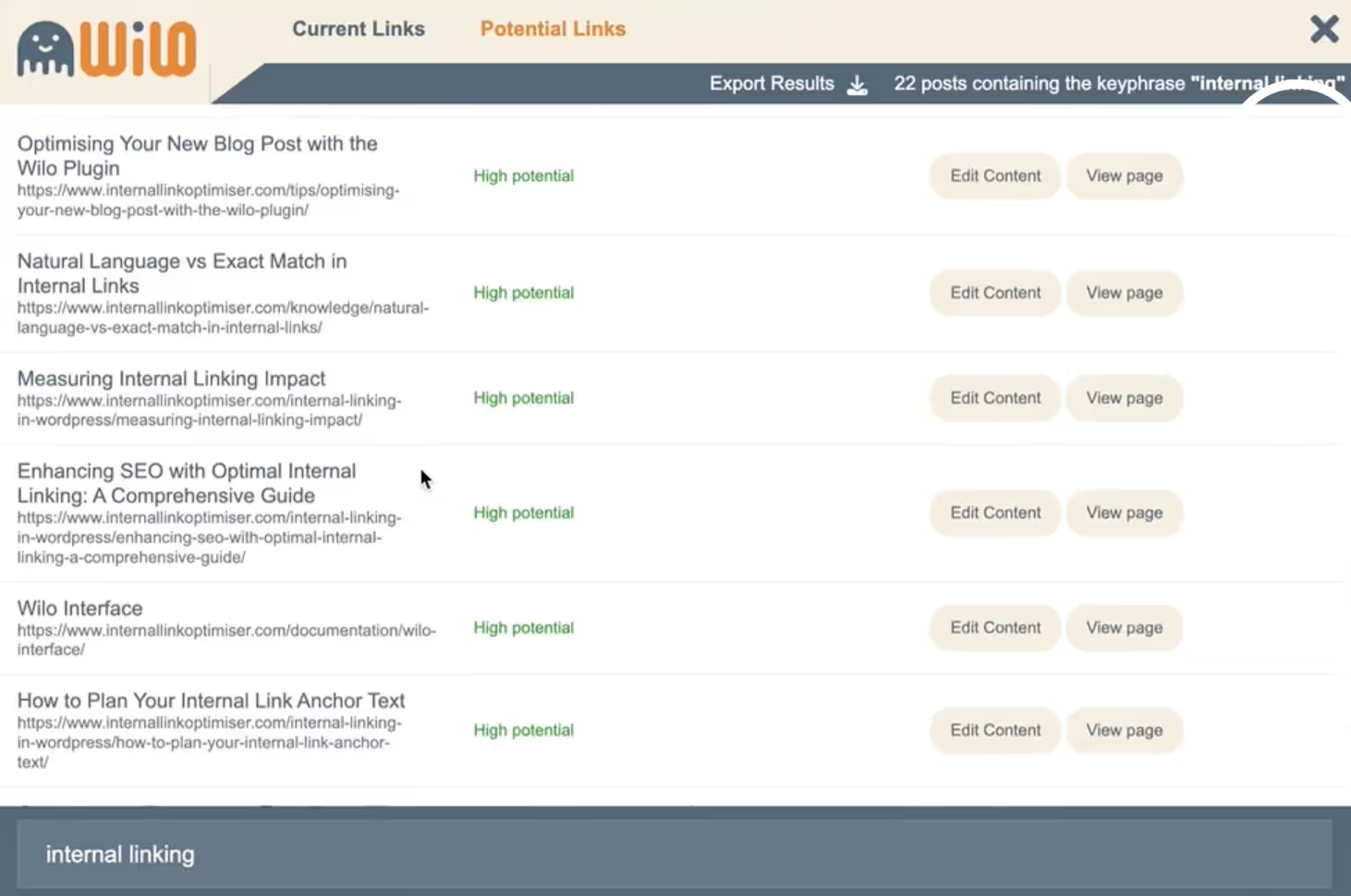
How it works: WILO is another WordPress plugin, but this one focuses solely on internal linking opportunities. It finds existing content to link to every time you publish new content.
There’s also an analysis feature that highlights the health of your internal linking strategy by giving each page a score. This gives you an overview of where you can improve your efforts and whether anchor text duplicates are bringing your score down (and where they are).
Features:
- Automatically find existing content to link to from your new pieces.
- An internal linking score analysis that highlights areas for improvement and provides a detailed breakdown of your internal linking strategy.
- Export data to a CSV or spreadsheet.
Pricing: Free.
Best for: Analyzing the health of your internal linking strategy.
6. Ahrefs

How it works:
Ahrefs is all about helping sites rank higher, so it’s no surprise that Ahrefs features an internal linking tool. The tool works by creating an internal linking report that identifies the top 10 trafficked keywords for each crawled page and looking for mentions of those keywords on your other pages. You can also filter results by domain rating to see which pages are your most authoritative. Any pages you link to from these high-ranking pages will enjoy a boost in link juice.
Features:
- A link opportunities report that looks for unlinked anchor text and keywords across your website.
- Advanced filters that find relevant keywords related to the page you want to add internal links to.
- Find your most authoritative pages.
Pricing: Starts at $99 a month.
Best for: Finding your most authoritative pages to link from.
7. LinkStorm
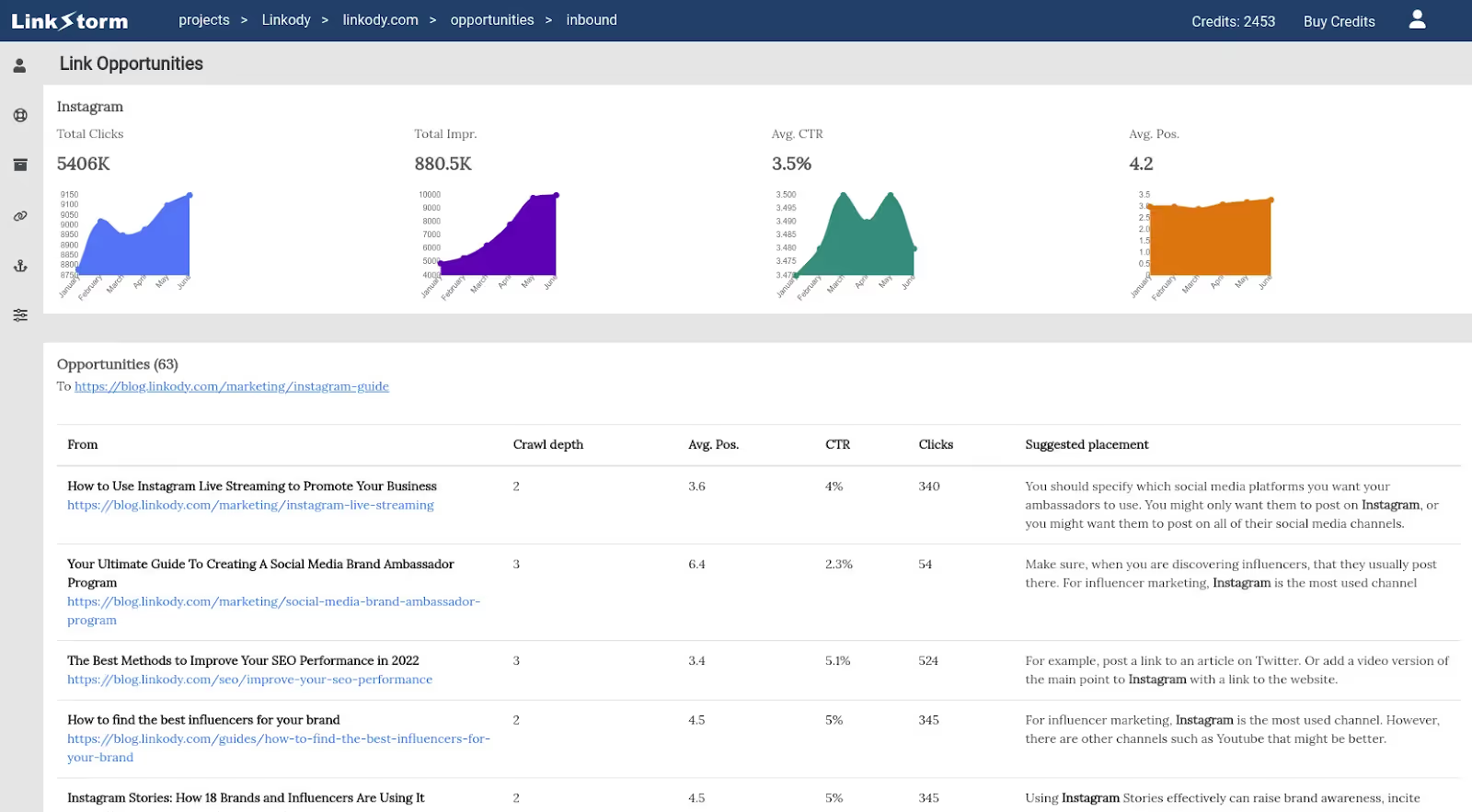
How it works: LinkStorm is a dedicated internal linking tool that analyzes your linking strategy and identifies opportunities. It works by crawling every page on your site to understand the content and then suggests relevant links between related pages or pages that target similar keyword clusters. The tool also highlights broken links, orphan pages, and poor anchor text so you can fix those problems.
Features:
- Audit your website’s current internal links to identify new opportunities.
- Create internal linking ecosystems between related pages and keyword clusters.
- Integrate with GSC to track traffic data alongside your internal link reports.
- Keep track of and optimize anchor text.
- Build links between all your websites.
Pricing: Prices start at $30 a month.
Best for: Optimizing custom target keywords to generate link opportunities for terms you’re trying to rank for.
8. InternalLinking
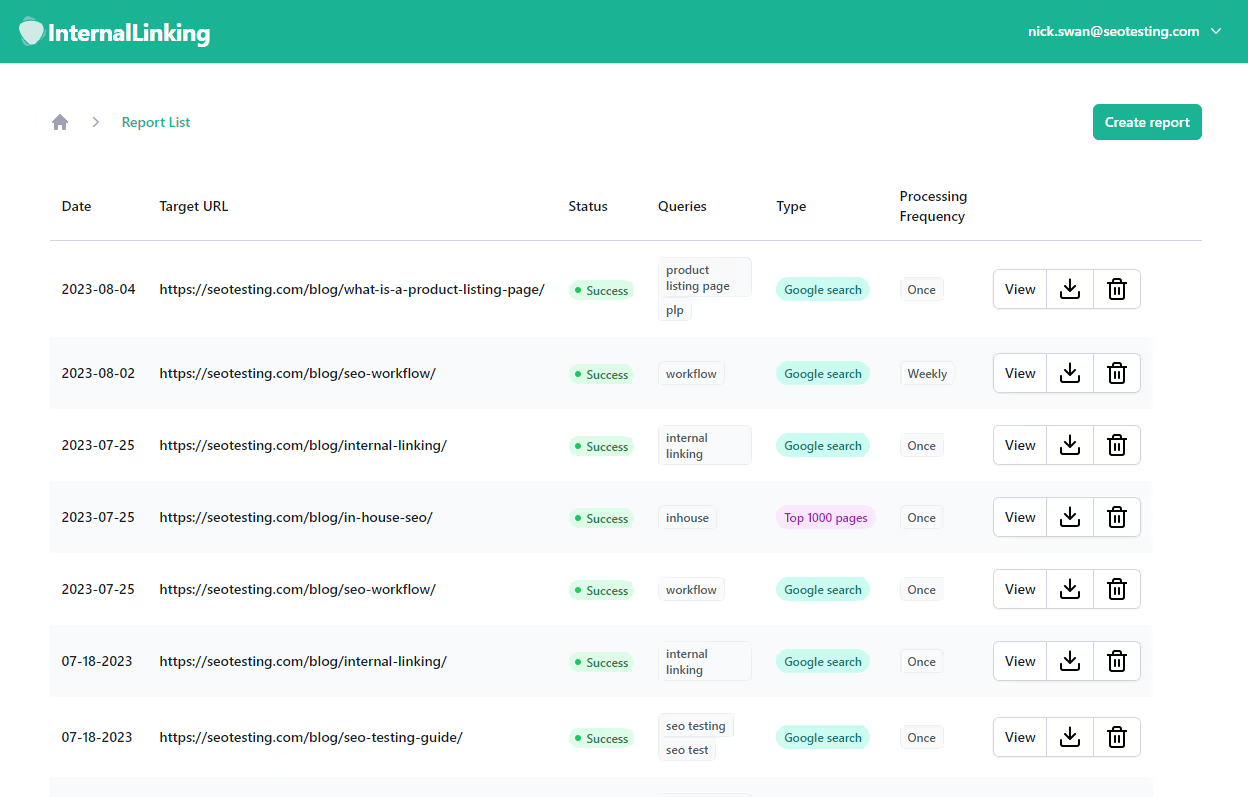
How it works: Internal Linking connects to GSC to reveal which queries each page on your site is ranking for. It’ll then suggest internal linking opportunities for these queries based on the keywords that already exist on the page.
Through detailed reports, you can get a list of target URLs and the paragraphs that include the GSC queries, as well as an indication of whether there are already internal links between the pages (you can hide the pages that are already linked so you only see new linking opportunities).
Features:
- Integrates with GSC to pull query data into detailed reports.
- Drill down into individual pages and identify unlinked anchor opportunities.
- Generate ongoing reports for your selected pages.
Pricing: Prices start at $20 a month.
Best for: Identifying opportunities to link from pages that already contain instances of keyword anchor text.
9. Internal Link Juicer
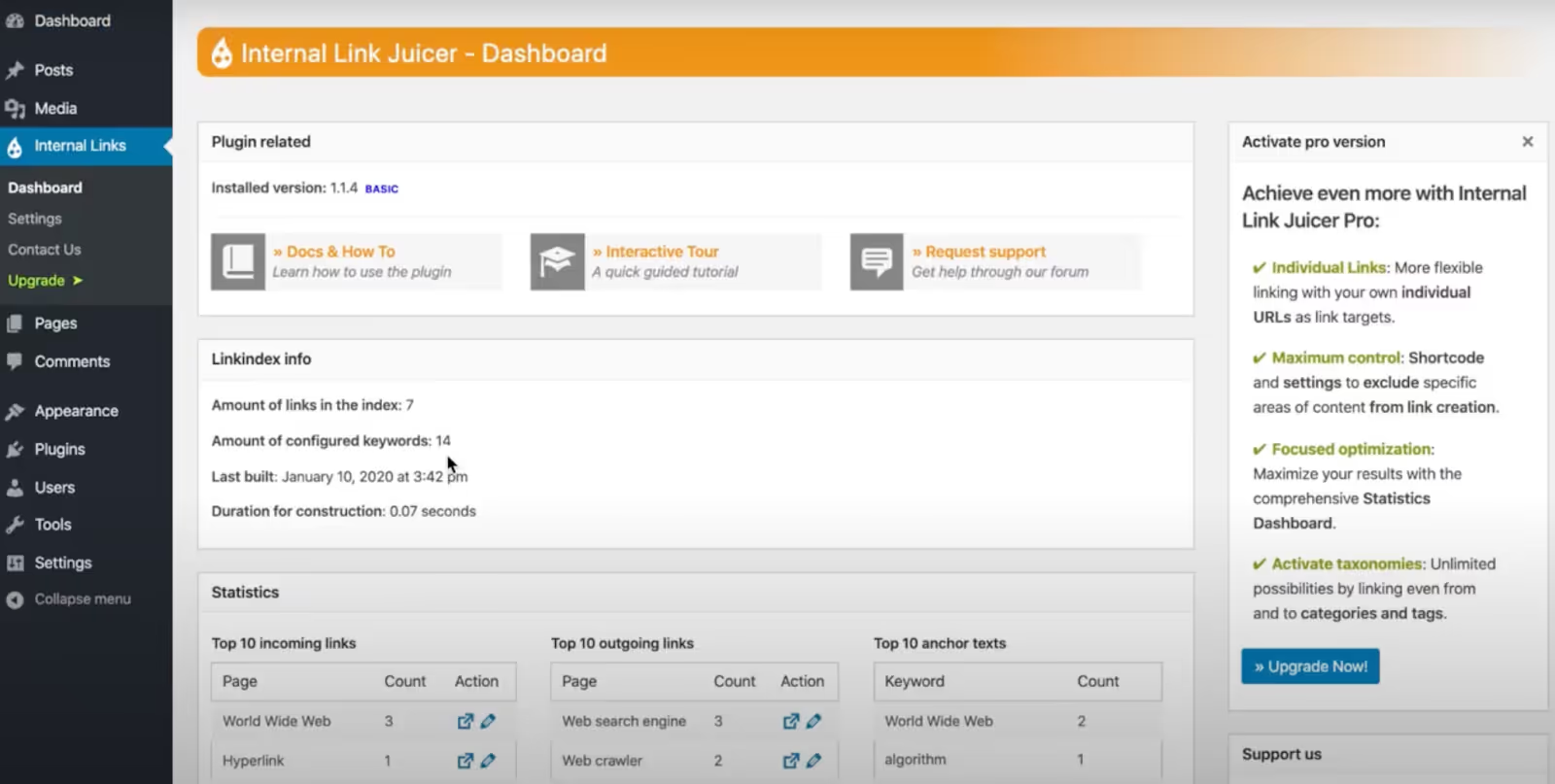
How it works:
Internal Link Juicer automates the internal linking process. Like Yoast and WILO, it’s a WordPress plugin that adds links to keywords directly in the WordPress editor. You can do this by entering the keywords you want to target in a new piece of content, and Internal Link Juicer will automatically apply links to source pages using those keywords. It also highlights orphan pages or those with very few links to them; you can see these pages in the stats dashboard.
Features:
- Automated internal linking and an intelligent gap feature that generates multiple links at once.
- Statistics dashboard that identifies issues like orphan pages and broken links.
- Configure keywords directly in the content editor.
Pricing: Prices start at $69.99 a year. There’s also a free plan.
Best for: Identifying link gaps and generating multiple links at once.
10. AIOSEO

How it works:
WordPress plugin AIOSEO has a ton of optimization features, but its Link Assistant is the one to pay attention to for internal linking. In addition to finding missed internal linking opportunities, the tool automatically generates reports so you can quickly spot areas for improvement. Once you’ve created a report, you can see suggestions on an individual post level, and you can find orphan pages and other low-hanging fruit.
Features:
- Automatically generated internal linking reports.
- Instant linking recommendations throughout your site.
- Color-coded scores that highlight your best and worst pages for internal links.
Pricing: Prices start at $49 a year.
Best for: Detailed internal linking reports.
11. SiteSeer
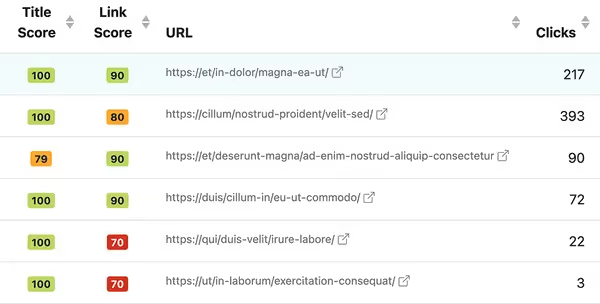
How it works: SiteSeer’s internal link audit feature helps you identify internal linking opportunities — it shows you where you can make the quickest and most effective improvements. The tool crawls your site to record and assess the effectiveness of your internal links, giving URLs a score based on several criteria, including the number of links to each URL, anchor text variety, and link placement. It can also highlight orphaned pages and generic and empty anchors so you can optimize these for quick wins.
Features:
- Internal link audit analyzes your existing internal link strategy and gives URLs a score based on several criteria.
- Identifies missed internal linking opportunities.
- Quickly finds the most relevant pages to link from.
Pricing: Prices start at $40 a month.
Best for: Running internal linking audits.
12. Screaming Frog’s SEO Spider
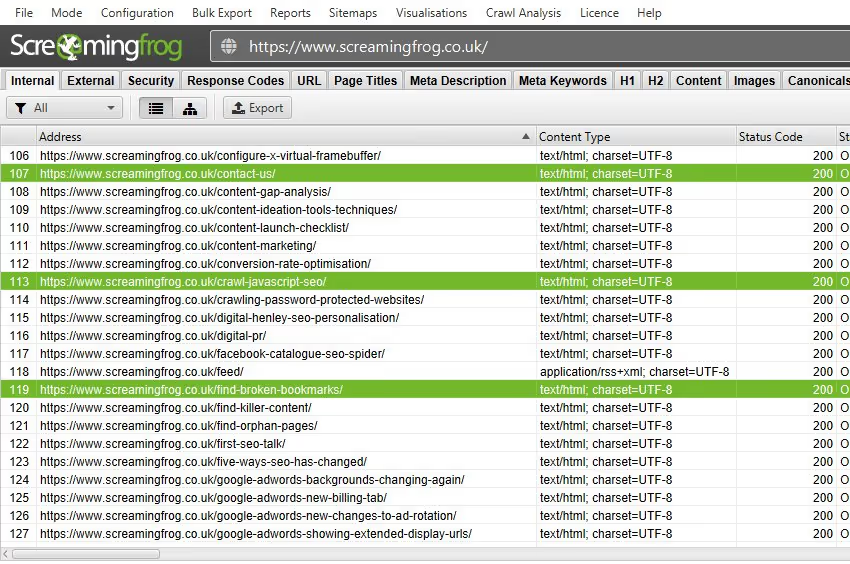
How it works: Screaming Frog’s SEO Spider tool helps brands improve their internal linking strategy by identifying broken links and missed opportunities. When you import your sitemap, the tool generates a list of every page on your website, which you can filter via page or select multiple pages at once. There, you can see all links found in the crawl or drill down further to only show links with specific anchor text. This will show you what anchor text is linking to what page so you can see any gaps in your strategy. You can also view link positions or where internal links are positioned within pages.
Features:
- Identify broken links and quickly fix them.
- Bulk-analyze links on multiple pages.
- Filter internal linking opportunities based on a specific link position.
Pricing: $259 per year. There’s also a free version.
Best for: Analyzing link position (that is, where links are on a page).
13. Frase

How it works: Frase’s internal and external links tool uses GSC data to show you which internal links are pointing to what pages on your site. You can integrate data from multiple domains and search for internal links by keyword or phrase. For example, if you want to find all internal links relating to SEO strategy, you can.
Features:
- GSC integration to pull data from multiple sites.
- Search for internal links by keyword or phrase.
Pricing: Prices start at $14.99 a month.
Best for: Searching for internal linking opportunities by keyword.
14. WebCEO

How it works: WebSEO is a 23-tool strong SEO platform, but its Internal Link Analysis tool is particularly useful for creating and maintaining an effective internal linking strategy. It also shows you what anchor text is used for each internal link, allowing you to review your entire link portfolio in one place to ensure that every link has relevant anchor text to the target page.
Features:
- In-depth link text analysis to check what anchor text is used across your site.
- Page Authority Analysis to determine whether individual pages are getting enough link juice.
- Optimize your internal link structure to give more authority to your highest-converting pages.
Pricing: Prices start at $37 a month.
Best for: Seeing a complete overview of your link portfolio in one place.
15. SEOClarity
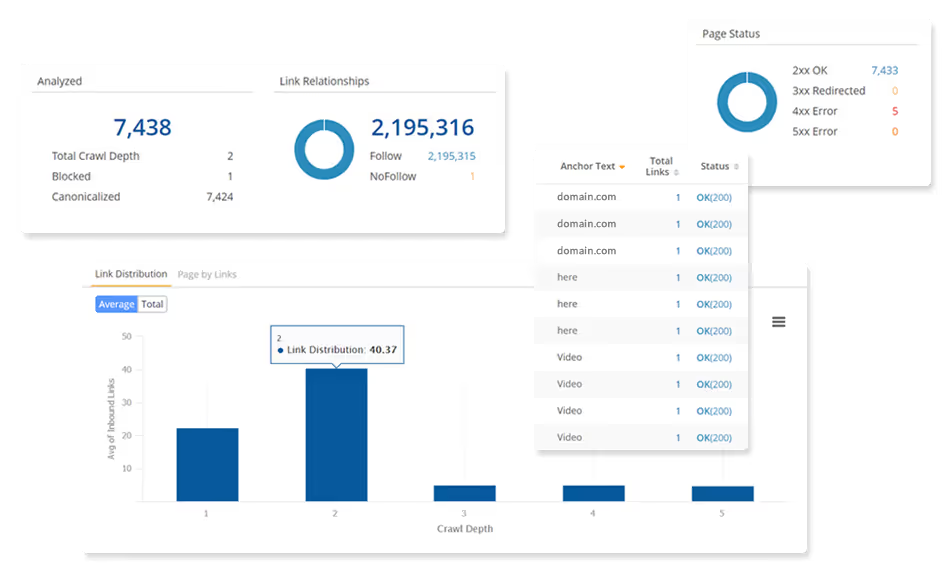
How it works: SEOClarity’s Internal Link Analysis tool reviews data on every page of your site to inform your internal linking strategy. Get an authority score for each page, and see your internal linking structure at a glance. In addition to finding broken links and orphan pages, the tool uses an advanced algorithm to predict the value of new links.
Features:
- Internal scoring that ranks your pages in order of authority.
- An advanced algorithm that predicts the value of future linking opportunities.
- A built-in crawler that reveals link distribution and crawl depth across all of your pages.
Pricing: Custom pricing.
Best for: Seeing how new linking opportunities will impact your site’s rankings.
Final Thoughts
Internal linking is a crucial factor in search rankings, but it’s also key to creating an easy-to-navigate site. Finding the right posts, anchor text, and linking opportunities can be time-consuming. Instead of doing it manually, use an internal linking tool to automate the process. The tools we’ve listed here will help you find internal linking opportunities in seconds, ensure that you’re using the correct anchor text, and allow you to connect similar posts and pages — thereby demonstrating topical relevance and authority.





